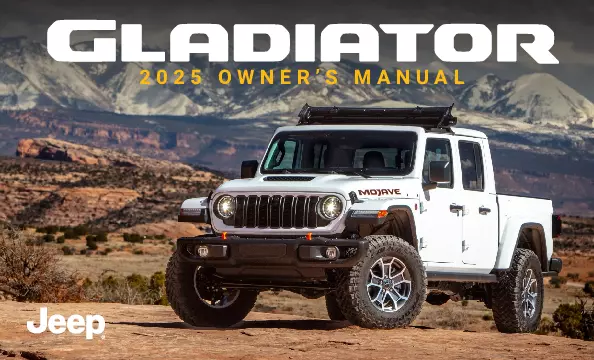2025 Jeep Gladiator Owner's Manual

Table of Contents
2025 Jeep Gladiator Overview
Introduction
The 2025 Jeep Gladiator continues to redefine the pickup truck landscape, seamlessly combining rugged capability with versatile performance. With its iconic seven-slot grille and bold exterior design, the Gladiator is unmistakably Jeep, transporting you from urban jungles to off-road adventures with ease. As a leader in the midsize truck segment, the Gladiator sets itself apart through a unique combination of utilitarian features and modern comfort, making it a choice for adventurers and daily commuters alike.
Powertrains
Powering the 2025 Gladiator is a choice of two robust powertrains. The standard engine is a 3.6-liter V6, delivering a hearty 285 horsepower and 260 lb-ft of torque, paired with a smooth 8-speed automatic transmission. For those craving more muscle, the Gladiator offers an available 3.0-liter EcoDiesel V6, generating 260 horsepower and an impressive 442 lb-ft of torque, perfect for towing heavy loads with efficiency. With both options featuring advanced four-wheel-drive systems, the Gladiator maintains the legendary off-road capability Jeep is known for.
Trims
The 2025 Jeep Gladiator comes in a range of trims designed to cater to various preferences and functional needs. The lineup includes the base Sport, the well-appointed Sport S, the versatile Overland, and the rugged Rubicon aimed at serious off-road enthusiasts. Each trim offers unique features and options, allowing owners to customize their Gladiator to fit their lifestyle, whether it's gear hauling, terrain tackling, or stylish cruising.
Features
Inside, the Gladiator is equipped with modern technology and comfort. Standard features include an intuitive Uconnect infotainment system with a touchscreen display, Apple CarPlay, Android Auto, and available premium audio systems. Safety is also a priority, with advanced driver assist systems available, including adaptive cruise control and blind-spot monitoring, ensuring peace of mind on every journey.
Owner's Manual
The 2025 Jeep Gladiator comes with a comprehensive owner's manual, providing detailed guidance on maintenance and operation. Your manual includes specifics on warranty coverage, maintenance schedules, and troubleshooting to ensure that your Gladiator continues to perform at the highest level. Additionally, it contains essential information about the advanced features and technologies, ensuring owners can fully utilize their vehicle not just for adventure, but everyday use as well.
User manual download
The Jeep Gladiator owner manual for the 2025 model year is to be found in PDF downloadable format on this page. The owner manual for the model year 2025 is free and in English, but the repair manuals are usually not easy to get and may cost more.
Manual Questions
Fill the form below and someone will help you!

